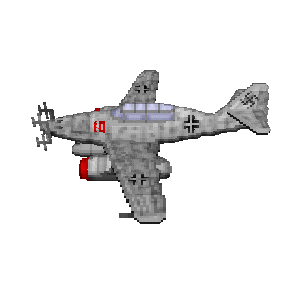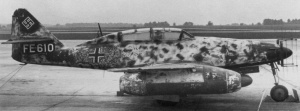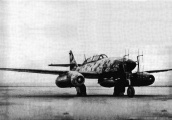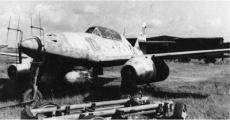Difference between revisions of "Messerschmitt Me-262 B-1a/U1"
m |
m |
||
| Line 20: | Line 20: | ||
The Messerschmitt Me-262 B-1a/U1 was a specialised night fighter variant of the Me-262 equipped with a FuG-218 Neptun radar for finding enemy aircraft in the dark. Development of a night fighter variant of the Me-262 started in late 1944 with the construction of the Me-262 A-1a/U2 prototype (Wk/nr 170056) which used the standard single seat A-1a airframe. Multiple tests were carried out using several different types of radar devices. While the technical sides of the tests proved successful the pilots however reported that they had difficulty flying and using the radar system simultaneously. In light of this it was decided to move development to the Me-262 B-1a two seater trainer airframe, the extra seat which was normally used by a flight instructor was instead modified for use by a dedicated radar operator who could guide the pilot to enemy targets. The addition of the radar antenna protruding from the nose produced extra drag and decreased the aircraft's speed, the space needed for the second seat required the removal of one of the fuel tanks too. To compensate for this loss two external fuel tanks were fitted under the nose, this also increased the drag and decreased the speed. Even with this loss in performance the Me-262 B-1a/U1 was still much faster then the enemy bombers and their escorts. Messerschmitt started work on developing a more advanced version called the Me-262 B-2a which would have featured a lengthened fuselage to hold more fuel instead of the external fuel tanks and the new "Berlin" centimetric radar dish which could be placed inside the nose reducing drag, the war ended before work on a prototype of this improved version could begin though. | The Messerschmitt Me-262 B-1a/U1 was a specialised night fighter variant of the Me-262 equipped with a FuG-218 Neptun radar for finding enemy aircraft in the dark. Development of a night fighter variant of the Me-262 started in late 1944 with the construction of the Me-262 A-1a/U2 prototype (Wk/nr 170056) which used the standard single seat A-1a airframe. Multiple tests were carried out using several different types of radar devices. While the technical sides of the tests proved successful the pilots however reported that they had difficulty flying and using the radar system simultaneously. In light of this it was decided to move development to the Me-262 B-1a two seater trainer airframe, the extra seat which was normally used by a flight instructor was instead modified for use by a dedicated radar operator who could guide the pilot to enemy targets. The addition of the radar antenna protruding from the nose produced extra drag and decreased the aircraft's speed, the space needed for the second seat required the removal of one of the fuel tanks too. To compensate for this loss two external fuel tanks were fitted under the nose, this also increased the drag and decreased the speed. Even with this loss in performance the Me-262 B-1a/U1 was still much faster then the enemy bombers and their escorts. Messerschmitt started work on developing a more advanced version called the Me-262 B-2a which would have featured a lengthened fuselage to hold more fuel instead of the external fuel tanks and the new "Berlin" centimetric radar dish which could be placed inside the nose reducing drag, the war ended before work on a prototype of this improved version could begin though. | ||
| + | |||
Only seven of the Me-262 B-1a/U1 night fighters were built before the end of the war, they were all given to the 10th squadron of the Nachtjagdgeschwader 11 who used them to great effect with several of the pilots becoming aces, including Kurt Welter who still holds the world record for the most enemy planes shot down in a jet aircraft. In an effort to neutralise this threat the RAF bombed the based they were operating from, after which only four aircraft were left. After the war the three remaining aircraft were captured by British forces who transported them back to Britain for testing, one of them crashed during a storm and another was scrapped. The third and final aircraft was given to the South African air force where it sat in storage for many years, it was then given to the Johannesburg Museum who restored it in 1971 and has since been one of their major exhibits. | Only seven of the Me-262 B-1a/U1 night fighters were built before the end of the war, they were all given to the 10th squadron of the Nachtjagdgeschwader 11 who used them to great effect with several of the pilots becoming aces, including Kurt Welter who still holds the world record for the most enemy planes shot down in a jet aircraft. In an effort to neutralise this threat the RAF bombed the based they were operating from, after which only four aircraft were left. After the war the three remaining aircraft were captured by British forces who transported them back to Britain for testing, one of them crashed during a storm and another was scrapped. The third and final aircraft was given to the South African air force where it sat in storage for many years, it was then given to the Johannesburg Museum who restored it in 1971 and has since been one of their major exhibits. | ||
Latest revision as of 13:12, 16 April 2017
| ||||||||||||||||||||||||||||
Only seven of the Me-262 B-1a/U1 night fighters were built before the end of the war, they were all given to the 10th squadron of the Nachtjagdgeschwader 11 who used them to great effect with several of the pilots becoming aces, including Kurt Welter who still holds the world record for the most enemy planes shot down in a jet aircraft. In an effort to neutralise this threat the RAF bombed the based they were operating from, after which only four aircraft were left. After the war the three remaining aircraft were captured by British forces who transported them back to Britain for testing, one of them crashed during a storm and another was scrapped. The third and final aircraft was given to the South African air force where it sat in storage for many years, it was then given to the Johannesburg Museum who restored it in 1971 and has since been one of their major exhibits.
Note
In game the Me-262 B-1a/U1 has weaker weapons and is slower than the standard Me-262 A-1a but features an extended view range and more health.
References
| 1930 - 1940: Pre-War |
1940 - 1942: Early-War |
1942 - 1944: Mid-War |
1944 - 1945: Late-War |
1945 - 1960: Post-War |
1930 - 1960: Total-War |
|
| Buildable | Yes | |||||
| Bonus Crate | Yes | Yes | Yes |







Enable comment auto-refresher